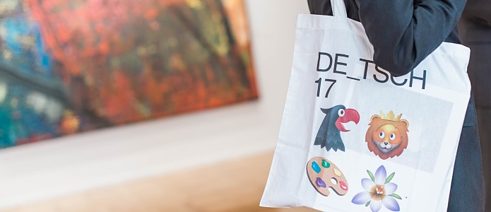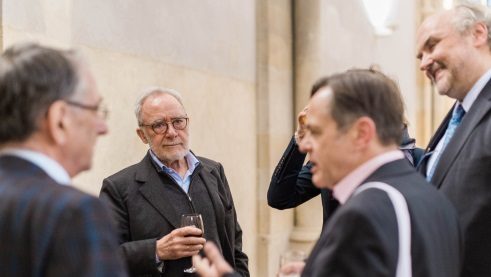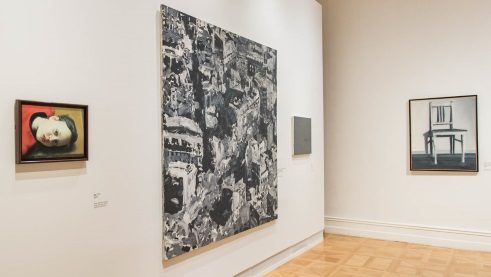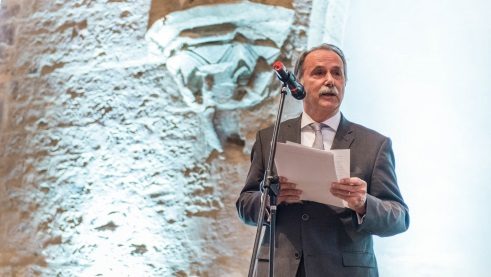Czech-German cultural spring
Gerhard Richter and the grey appeal of randomness

Ema, Betty, Gudrun, Rudi ... these are names one should know in order to navigate contemporary painting. People with these names are on the pictures by painter Gerhard Richter that can be seen at the National Gallery in Prague being held as part of the Czech-German Cultural Spring in cooperation with the Goethe-Institut Prague.
At the Gerhard Richter retrospective for the Czech-German Cultural Spring, the Goethe-Institut will reveal the spectrum of the artist’s works at the National Gallery in Prague. It is an exhibition premiere in Central and Eastern Europe.
Gerhard Richter explores the possibilities of painting in all conceivable directions and feels his way into spheres where many of his colleagues do not dare to go. His works are so dissimilar that the visitor might be surprised that all of the paintings are signed by the same painter. The only uniform element of the exhibition is the colour grey, which, according to Richter, is “the ideal colour for indifference, silence, despair.” It is seen in its variability on both monochrome canvas pictures and intimate portraits. From the title picture of 1977 to Richter’s iconic work of 1988, on which a girl turns her back to the viewer and looks towards the grey canvas, the face of the exhibition is that of Richter’s daughter Betty.
LOOKING TO THE PAST
In some cases, Richter’s bold artistic approach has also been met with incomprehension and criticism, such as his picture Onkel Rudi, which is still almost always locked in the depository. The artist dedicated the only original by Richter in the Czech Republic to the Lidice Memorial. For Richter himself, however, this was a very important moment in reappraising his family history. While his father and his uncle served in the German army, Richter’s aunt Marianne, who suffered from schizophrenia, was a victim of Nazi racial hygiene. The picture Herr Heyde shows the blurred face of the psychiatrist who was chiefly involved in planning the systematic murder of innocent people and whose true identity was only discovered in 1959. Gerhard Richter, Jiří Fajt and Dr. Berthold Franke
| Photo: Pavlína Jáchimová/Goethe-Institut
According to Jiří Fajt, director of the Prague National Gallery, Gerhard Richter is obsessed with dealing with the past, whether his own experiences or events that made a major impression on him. Richter himself does not want his works to be didactic. Instead, he emphasizes their humanistic message. At the Convent of St Agnes in Prague’s old town, four abstract paintings by Richter are shown that he produced based on photographs from the Auschwitz extermination camp. According to Richter, the abstraction allows the viewer to better reflect the feeling of oppression caused by the documentation of the atrocities.
Gerhard Richter, Jiří Fajt and Dr. Berthold Franke
| Photo: Pavlína Jáchimová/Goethe-Institut
According to Jiří Fajt, director of the Prague National Gallery, Gerhard Richter is obsessed with dealing with the past, whether his own experiences or events that made a major impression on him. Richter himself does not want his works to be didactic. Instead, he emphasizes their humanistic message. At the Convent of St Agnes in Prague’s old town, four abstract paintings by Richter are shown that he produced based on photographs from the Auschwitz extermination camp. According to Richter, the abstraction allows the viewer to better reflect the feeling of oppression caused by the documentation of the atrocities. Pictures of the exhibition
| Photo: Pavlína Jáchimová/Goethe-Institut
The selection of the paintings and the overall concept of the exhibition reveal the range of Richter’s artistic expression and his interest in historical references.
Pictures of the exhibition
| Photo: Pavlína Jáchimová/Goethe-Institut
The selection of the paintings and the overall concept of the exhibition reveal the range of Richter’s artistic expression and his interest in historical references.He thus became the role model for many ensuing generations of artists, which is particularly true of the Dresden artist Eberhard Havekost. An overview of his work is being shown at the same time in a large exhibition at the Rudolfinum Gallery in Prague.
 Klaus-Dieter Lehmann, president of the Goethe-Institut, opens the Deutsch-tschechischen Kulturfrühling
| Photo: Pavlína Jáchimová/Goethe-Institut
Klaus-Dieter Lehmann, president of the Goethe-Institut, opens the Deutsch-tschechischen Kulturfrühling
| Photo: Pavlína Jáchimová/Goethe-Institut